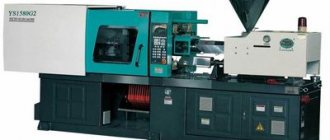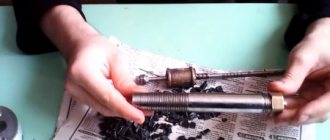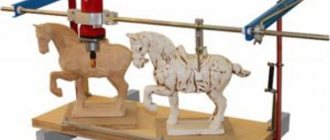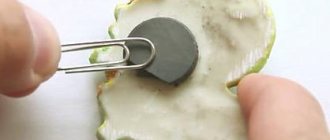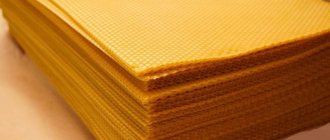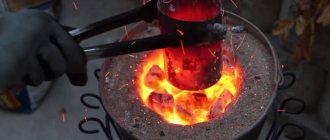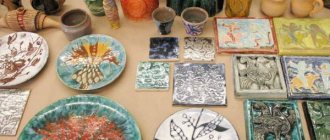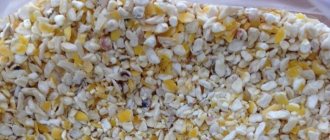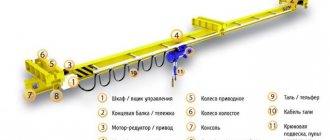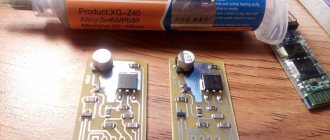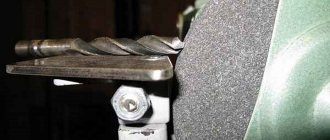Pavel Cherepnin talked about such a cool thing as a thermoforming box. It allows you to melt plastic at home, make various parts and shapes from any plastic waste, such as a canister or a plastic bottle, at home.
So, this time another useful device is a box for thermoforming plastic. Using such a box, we can make any shape from plastic. Make masks from plastic. cases for any equipment, boxes with molds for tools, in general, any plastic part or toy we want. We are limited only by the size of the frame. But this can also be overcome by making a larger thermoforming box. the principle is this. The main part of the device is a sealed box with a grill installed instead of the top side; we connect a vacuum cleaner to the wall of the box, which pumps out air from the inside, thereby attracting plastic to the grill. A plastic sheet is fixed between two frames. It is advisable to use plywood and not chipboard as I did. I took the plastic itself from plastic cans and bottles. I made two frames. One large size, for canisters and one smaller, for bottles. We heat the plastic in the oven to about 120 degrees so that it becomes plastic. Then we put the mold on the grill, turn on the vacuum cleaner and press the frame with the heated plastic against the box. The air will draw in the plastic and give it a blank shape.
Preparation of material for casting
At home you can create lids, toys, souvenirs, household utensils and other solid objects. For the procedure you need to prepare a number of materials:
- plastic for casting;
- melting container;
- master model;
- mold;
- lubricant
And other means.
For casting, plastic scrap can be used, which is crushed and melted. However, the melting point of all types of plastics differs, and only one specific type is used to create the blank. If this rule is not followed, the plastic melts unevenly and the parts created from it turn out to be inhomogeneous and bubbly.
At home, it is easier to use ready-made mixtures, such as liquid plastic or epoxy resin. The material does not require melting, it cooks and sets quickly, and products made from it are not inferior in quality to analogues. As an alternative, AKP-7 powder is also suitable, requiring mixing with a solvent. It takes longer to prepare plastic from it, but the result is pleasing.
However, if you still decide to melt scrap, for example, old boxes, buckets, dishes, you should follow safety precautions and carry out casting in ventilated, non-residential areas, since plastic fumes are toxic and dangerous to humans.
Making the body of the box
First you need to make the body of the drawer. Of course, you can take something ready-made, for example, from old furniture. But certain dimensions were required for the production of masks and parts for cars, which had to be made from scratch.
I used old boards. I found literally rubbish and garbage lying around the garden, along the street, which was lying around and no one needed. I had to cut, remove all unnecessary parts, protruding ends, and irregularities so that the boards were even and the same height and width. I made the size according to the face, took a cast from cement and made a box based on it. This is needed to make masks. Therefore, I focused on the largest sizes that may be required. I cut everything out with a circular saw, a jigsaw is acceptable, but working with a saw is much more convenient and faster. The result is a frame. A groove had to be made along the top of each board to accommodate the grille. Grate for conducting air into the box. Connect a vacuum cleaner to the box itself, and create a vacuum or, more simply put, a vacuum inside the box, and attract plastic. I made cuts along the edges of each board at the ends, coated them with glue using a glue gun, and stuck all the parts together. The result is a box. Then I secured all the corners with self-tapping screws. After fastening it turned out to be strong, the screws and glue simply hold it tightly. You need to do the bottom.
I found chipboard from furniture. Let's draw the bottom. Let's cut off the excess. Chipboard is difficult to saw - it is a dense material. The box for melting and shaping plastic is ready.
Making your own mold
The production of plastic products without a molding container is impossible. You can make it yourself, and silicone is best suited for these purposes. It can be coated or filled, both options are suitable. The main thing is that the elongation coefficient is at least 200%. It is worth paying attention to the viscosity level. The smaller it is, the more detailed the mold will be.
To make a blank, you need to have a master model - a sample for future products. It can be created from plaster, wood, plasticine, printed on a 3D printer, or used from an existing part.
Stages of making a casting mold:
- Coat the master model with a thin layer of lubricant, for example lithol.
- Place in prepared formwork and fill with silicone.
- Or coat it with a brush if coating silicone is chosen.
- Wait about 8 hours until the material hardens.
- Remove the form from the formwork and make a hole for filling.
- Cut into 2 equal parts and remove the model.
In this way, a collapsible mold is obtained, which is suitable for casting symmetrical plastic products. But you can also make a one-piece mold for blanks that are simple in design. It is made from paraffin, which is filled with plaster. After hardening, the paraffin is melted out of the mold by slowly boiling it.
Silicone molding process
When the mold is made and the material is prepared, you can start casting plastic at home. At the first stage, the workpiece is thoroughly cleaned of possible debris and coated inside with a lubricant. For better separation, its edges should be lubricated with soapy water. Then the two halves of the springform pan are connected and secured with tape or rubber bands.
Two-component plastic is diluted in a separate container or the plastic is prepared in another way, depending on what is chosen as a raw material. At this stage, dye is added to the material. Liquid plastic polymerizes in 10-15 minutes, so you need to work quickly.
The finished material is poured into the mold in a slow stream, so that the injection hole is also filled. After hardening, the plastic shrinks and the product takes on the required shape. After waiting for the time indicated in the characteristics, for liquid plastic it is 15 minutes, you can remove the model.
Powder casting
To prepare plastic, AKR-7 powder is mixed with a solvent to form a dough. The proportions are indicated on the packaging. The resulting raw material is poured into molds and waited for up to 30 minutes, and then compacted with a stick through the casting hole until at least 3–5 mm is cleared from the upper edge of the mold.
The casting hole should be closed and tightened, for example, with a clamp. The mold is placed in water at room temperature and brought to a boil. The workpiece is cooked over low heat for about 40-45 minutes and after turning off the oven remains in the water for another 20 minutes. After the material has cooled, the mold can be separated and the plastic product created at home can be removed.
Principles of writing a business plan
Like any other business plan for the organization and operation of an enterprise aimed at processing plastic bottles and other plastic products, it is drawn up in accordance with the requirements for such documents by the reviewing specialists. This must be taken into account, because a business plan is prepared not so much for oneself, but for those who, on its basis, will allocate the money needed to turn the idea into practice. Financial specialists are the most picky. If you yourself don’t know something thoroughly, you will definitely turn to specialists to get an assessment of the proposed document. Therefore, the document being created must comply as much as possible with accepted standards, since, as they say, you meet people by their clothes.
Before writing, you need to clearly understand that a business plan, in essence, is simply a written explanation of the proposed project, the amounts required for its implementation, as well as the optimal time frame for implementation. This approach to the matter will immediately clarify what is main and what is secondary, what needs to be emphasized and what needs to be relegated to the background.
Information about the project of the future enterprise is divided into several sections:
- Section I.
Title page. Here preamble information about the name of the enterprise, its form of ownership and address is posted, the name of the proposed project is posted, telephone numbers and email addresses are posted. The date of preparation of the document is indicated and information is provided on the need to calculate cash costs and profits, which are included in the document or placed in a separate appendix. - Section II.
This section containing copyright information is often referred to as the “Confidentiality Memorandum.” It sets out information about the authors of the business plan materials and their rights, obligations regarding non-disclosure of information received without the author's consent, as well as obligations to return the business plan after reading it if the decision on it is not positive. - Section III.
This section is often called the “Summary”. This section briefly outlines the entire business plan and reveals the essence of the project. It is recommended to create this section after writing the entire business plan and arrange the information following the following structure:
- project description;
- resource provision;
- ways and means of implementation;
- the answer to the question - what is unique about the project;
- required investment amount;
- projected profit;
- ways to return money to investors;
- effectiveness of the proposed project.
- Section IV.
Objective of the project. This section describes the intended purpose of the proposed business, describes the services or goods supplied to the market, indicating the benefits that customers will receive. For this purpose, the advantages of the manufactured products are described in detail. If there is their uniqueness, this moment should be described as carefully and extensively as possible. If the latest technologies are used, it is necessary to indicate how copyright will be implemented. - Section V.
Market analysis in the area of the proposed business. Here the results of marketing research regarding the products offered are presented, and the activities of competitors are analyzed. If, when writing a business plan, there is no uniqueness of the proposed business in a given region, the emphasis is on reducing costs through the use of new technologies, reducing energy costs, personnel, and so on. It is imperative to take into account that today there are practically no areas that are no longer covered by business, therefore, having found competitors, you need to justify why the proposed business is more attractive. - Section VI.
Position of the created enterprise in the industry. Here the main characteristics of the enterprise are described and, based on their analysis, the place of the planned production or trade in the existing industry is noted. The preferred form of ownership of the enterprise is indicated and what costs will have to be incurred to create it. The section also contains information about:
- company address;
- the type of premises required, indicating whether it already exists or needs to be purchased, whether repairs are necessary or not;
- economic performance indicators;
- temporary characteristics of the specifics of production activities.
If the business is planned to be started from scratch, the presence or absence of experience in this area of the proposed management is indicated. The manager’s lack of experience in the proposed field is a very negative characteristic and, as a rule, initiates the refusal of third-party investors.
- Section VII.
Product Description. The section is created after an analysis of the existing market. Based on the analysis, a conclusion is drawn about the advantages of the proposed product and the competitive ability of the company. Product samples or their photos and a description of technical characteristics must be present in this section or attached to it. If several units of a product are produced, each of them is described in detail. Structurally, the section is divided into several subsections:
- the name of the product, as well as its description;
- purpose and areas of use;
- specifications
- competitive advantages;
- presence or absence of copyrights;
- environmental friendliness of the product or lack thereof;
- quality certificates;
- service and operation.
- Section VIII.
Sales of products. The section contains a marketing plan for the sale of the manufactured product. Such a plan should include:
- market behavior patterns;
- reasoned explanation of the quantity of products purchased by customers;
- describes the methods used to influence demand;
- describes the methodology for calculating prices;
- information on methods of sale is provided;
- the legal status of the main consumer is indicated.
Any material on organizing a business includes a governing advice - find the customer. This is what a marketing plan is designed to do. This structural unit is subject to close study, so it is necessary to indicate in detail:
- what criteria for evaluating the product from the consumer’s point of view were studied when writing the business plan;
- what place in the supply chain occupies the client to whom the goods are supplied.
This section is based on the characteristics with which the product is assessed not by the manufacturer, but by the consumer. It is very desirable to provide an analysis of the evaluation of a similar product by competitors’ consumers and, based on this information, justify the attractiveness of your own product. This section also includes the logistics concept - how and to whom the goods are delivered, who is responsible for sending them. A strategy for conducting advertising campaigns is given. Prices and sales volumes are indicated by time periods. Payback periods and profitability are calculated.
- Section IX.
Production plan. The material in this section requires close attention and elaboration, especially in cases of planning to open a company from scratch. The section describes and analyzes in detail the chain of production of the product, examines the premises and the equipment located in it, its location, transportation routes for raw materials, parts, finished products, and so on. Not only a comprehensive description of production is provided, but also control over its processes, it is indicated which aspects will be entrusted to subcontractors, and the reasons for their choice are indicated. This section describes all production costs, and also calculates the cost of the product, provides a cost estimate, and indicates variable and fixed costs. The information is arranged following a specific structure:
- production structure;
- technology used;
- what kind of premises are needed;
- staffing needs;
- raw materials;
- equipment characteristics;
- production capacity;
- cost estimate;
- selection of subcontractors;
- cost analysis.
- Section X.
Organizational plan. The section describes organizational issues, lays out regulatory documents and describes how they will be implemented. - Section XI.
Financial planning. Information about the required financial investments and their expenditure is posted here. The timing of financial movements, the timing of stages, and the finances for working capital are also outlined. It is also indicated if there is a need to attract loans and how they will be repaid. In this section, the conclusion of the above is an analysis of the effectiveness of the company and its work. Structurally it looks like this:
- profit received;
- tax payment structures;
- need for investment;
- loan servicing;
- description of project effectiveness
- Section XII.
Risk analysis. The section contains information about difficulties that may hinder the implementation of the project. This includes difficulties caused by legislation, weather, competitors, and so on. The more complete the list indicating ways to solve difficulties, the higher the assessment of the plan as a whole.
The difficulties of doing business include the wrong choice of employees - success depends not on the degree of familiarity, but on professionalism.
To assess the degree of risk, the following analysis methods are used:
- statistical method (based on the study of known statistics);
- method of analogies - analysis based on studying the development of similar projects;
- expert method, the basis of analysis is expert opinion;
- modeling - the response to external influence is analyzed.
A description of possible risk countermeasure systems is also provided, and possible guarantees are named - government authorities, product guarantees, bank guarantees, and so on.
- Section XIII.
Applications. Here we collect documents that are not included in the planning description, but which are important, copies of contracts for similar products, data sources, price lists, etc.
Scrap plastic can be found everywhere.
Old broken things constantly appear at home, the street is full of bottles and packaging. A hobbyist might have the idea of collecting it all, grinding it up and melting it into something valuable. A novice “foundry worker” should not do this, since each type of plastic has only its own properties, so it would have to be melted at different temperatures. In addition, in production, parts are usually cast in special installations where high pressure is maintained.
Even if you manage to select pieces of plastic of the same type and crush them, bubbles will form when melted. So it’s best to go to a hardware store and buy liquid plastic, from which the parts are no less durable than factory ones. Epoxy resin can also replace plastic. You will also need: - silicone; - large capacity; — .
If you do decide to make something from scrap plastic, do not do it indoors. Plastic fumes are toxic.
Home manual casting machines
For small-scale casting of plastic parts, tabletop machines can be used. This is compact equipment that will fit in any private workshop or garage. Plastic can be poured onto them in single or multiple forms, depending on the size and serial production. The units differ from industrial equipment only in their small size. The tabletop press is suitable for all polymers and is easy to operate.
Stages of casting at home on a machine:
- Installation of the apparatus and injection nozzle.
- Installing the mold and lubricating it with silicone;
- Loading polymer into the hopper;
- Heating and stirring the material using a screw;
- Pouring raw materials into molds;
- Waiting for cooling;
- Removing the plastic part.
Welding extruders can also be used in everyday life to fasten plastic parts to produce more complex products.
It is possible to make plastic products with your own hands individually, as entertainment, or for a one-time need. And also in bulk, for sale or for subsequent production. Homemade forms and improvised means or specialized home equipment are suitable for this. It is more profitable to entrust mass casting to specialists, since this requires expensive, large equipment and the work of experienced personnel.
What can be made from PET bottles
For people with creative imagination, plastic bottles are an inexhaustible source of inspiration.
You can also make strong ropes from plastic bottles. To do this you will need a “bottle cutter”. Craftsmen make this simple device from a blade, several washers, mounted on a wooden base.
When assembled, the bottle cutter looks like this.
Reels on which threads obtained from PET bottles are wound can also be made from bottle necks. First, cut off the necks of two bottles and the tops of two caps. The cut caps are fastened onto the rod, onto which the cut necks are then screwed; holes are made in the necks with a hot nail through which the beginning of the thread is passed and, after tying a knot, it is fixed.
The resulting tapes can be used not only to make ropes, but also to make tubes from them. To do this, a strip cut from a plastic bottle is passed through a hole of the required diameter for the tube and, when heated, begins to be pulled through it. The principle of operation is clear from the photo.
It is quite possible that such a mini-business would be suitable for someone, the equipment requiring only a bottle cutter with reels and premises, such as the production of brooms and brooms from plastic tapes. How such products are made can be easily understood from the picture.
Perhaps many people will think that the bottle ribbon business is very small and not worth attention. However, in India it is serious business. Several vertically placed bottle cutters are used, the cut strips are wound on reels that rotate from a mechanical drive. One worker installs bottles on bottle cutters and ties the resulting strips, the second worker controls the speed of rotation of the reels on which the strips are wound, from which ropes are subsequently produced.
Recently, tiles made from PET bottles have become increasingly popular in southern countries. The molten flex is mixed with a mineral filler (fine sand fractions) and filled into molds through an extruder. In the countries of the former USSR, such business is just beginning, so the field for the activities of craftsmen is quite wide.
Paving slabs, chain-link mesh, greenhouse walls and much, much more are also made from plastic bottles.
But no matter what the entrepreneur decides to manufacture from such recyclable materials, success, as in any business, will depend on the literacy of drawing up a business plan. Such a document will not only allow you to organize knowledge and build a system of actions, but can be useful if you need to attract investment money.

